Acer R7 Review: Something Different
by Jarred Walton on August 15, 2013 12:45 AM ESTI’m going to stuff all of the benchmarks onto one page for this review; there’s really nothing noteworthy about the performance of the R7, at least on the CPU and graphics side of things. Battery life and display quality are a bit more important, but given the timeliness of this review (or the lack thereof), most of what we wanted to say was covered on the previous pages. So, here are the benchmarks, using our updated 2013 mobility suite. I’ll save a bit of short commentary for after the break.
First, here’s a quick overview of the laptops we’re including in our graphs. With the update to our 2013 mobile test suite, we’re somewhat at the mercy of our results database. Most of our comparisons that are meaningful are going to be with Ultrabooks, and given that were dealing with basically Ultrabook hardware the Acer R7 posts similar performance. We tossed in the MSI GX60 Richland APU notebook as a comparison, not because the notebooks are similar but because the A10-5750 APU more or less competes with Ivy Bridge ULV processors. Note that we did not run every benchmark on every laptop, so some charts might be missing certain laptops.
| Specifications of Benchmarked Laptops | ||||||
| Laptop | CPU | GPU | Storage | RAM | LCD | Battery |
| Acer R7-571-6858 | Intel Core i5-3317U | HD 4000 | 500GB HDD + 24GB SSD | 1x4GB + 1x2GB | 15.6” 1080p Glossy AHVA Touchscreen | 4-cell 54Wh |
| Acer S7-391-9886 | Intel Core i7-3517U | HD 4000 | 2x128GB RAID 0 SSDs | 2x2GB | 13.3” 1080p Glossy IPS Touchscreen | 4-cell 35Wh |
| Acer S7-392-9890 (Preview) | Intel Core i7-4500U | HD 4400 | 2x128GB RAID 0 SSDs | 2x4GB | 13.3” 1080p Glossy IPS Touchscreen | 4-cell 46Wh |
| AMD Kabini | AMD A4-5000M | HD 8330 | 256GB SSD | 1x4GB | 14” 1080p Matte IPS | 4-cell 45Wh |
| Apple MacBook Air 13 (2013) | Intel Core i5-4250U | HD 5000 | 128GB SSD | 2x2GB | 13.3” 1440x900 Glossy TN | 4-cell 54Wh |
| Clevo W550EU (Mythlogic) | Intel Core i5-3340M | HD 4000 | 256GB SSD | 2x4GB | 15.6” 1080p Matte IPS | 6-cell 62-Wh |
| HP Spectre XT TouchSmart | Intel core i7-3517U | HD 4000 | 500GB HDD + 32GB SSD | 2x4GB | 15.6” 1080p Glossy IPS Touchscreen | 4-cell 48Wh |
| Lenovo ThinkPad X1 Carbon | Intel Core i5-3427U | HD 4000 | 180GB SSD | 2x2GB | 14” 1600x900 Glossy TN Touchscreen | 4-cell 45Wh |
| MSI GE40 | Intel Core i7-4702MQ | HD 4600 / GTX 760M | 128GB SSD + 750GB HDD | 1x8GB | 14” 1600x900 Matte TN | 6-cell 65Wh |
| MSI GX60 | AMD A10-5750 | HD 8650G | 750GB HDD | 1x8GB | 15.6” 1080p Matte TN | 9-cell 87Wh |
| Toshiba KIRAbook | Intel Core i7-3537U | HD 4000 | 256GB SSD | 2x4GB | 13.3” 2560x1440 Glossy IPS Touchscreen | 4-cell 52Wh |
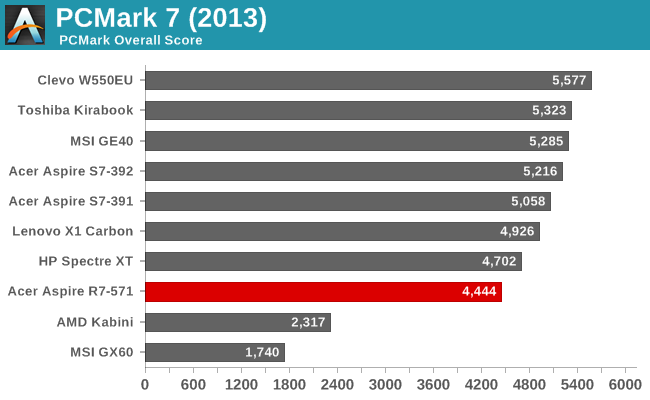
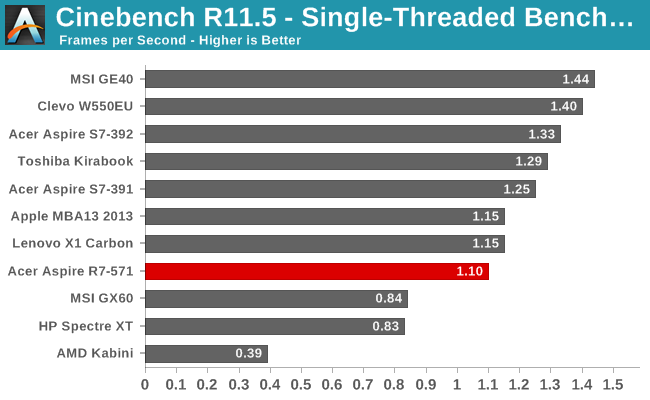
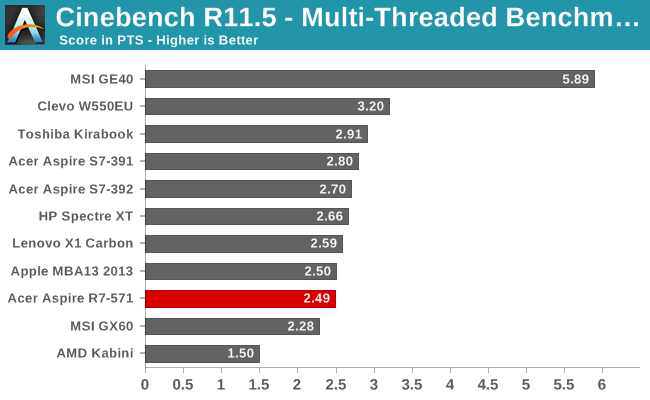
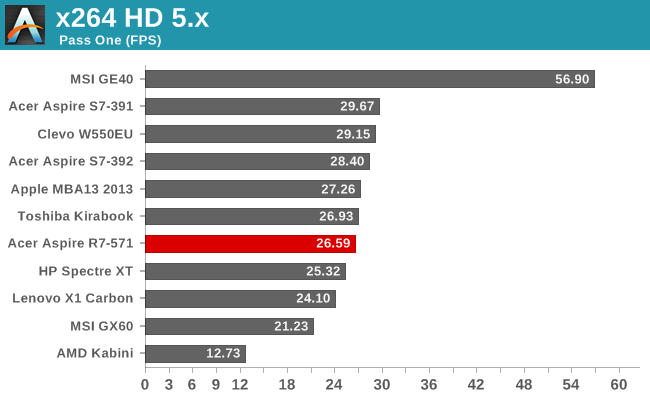
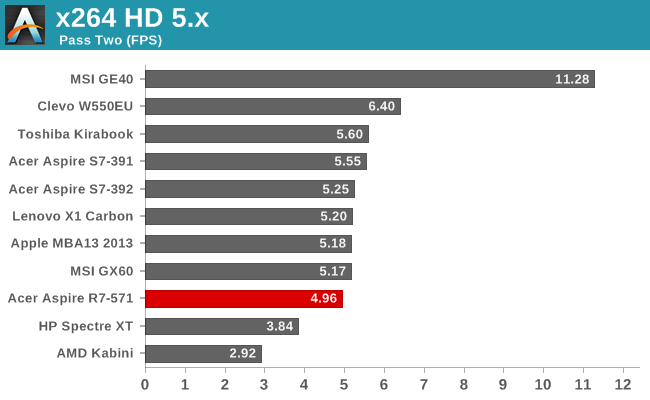
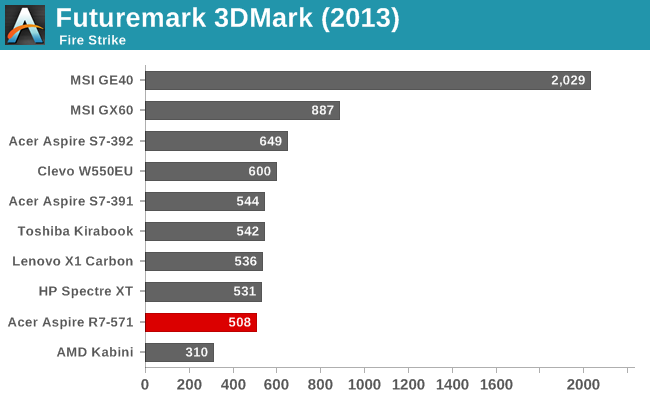


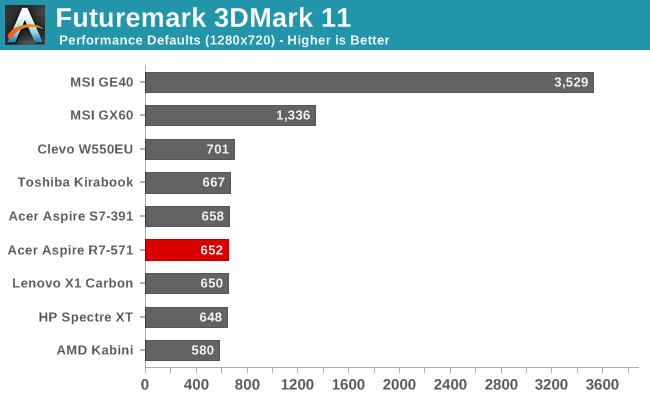
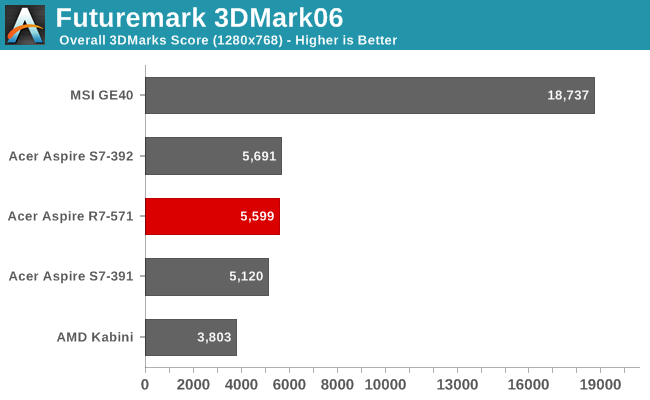

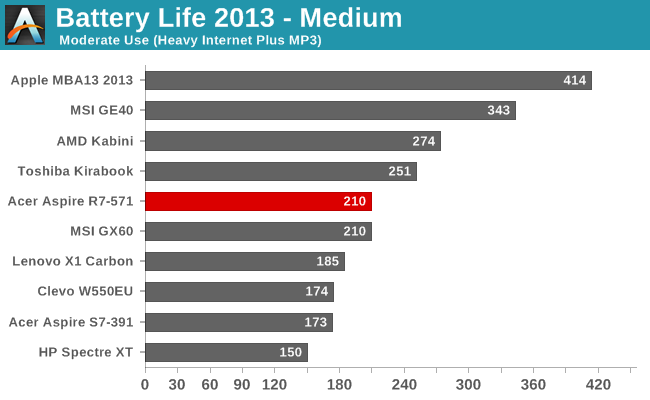
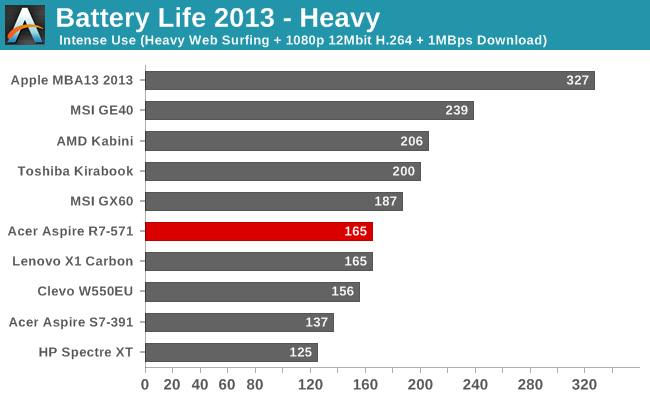
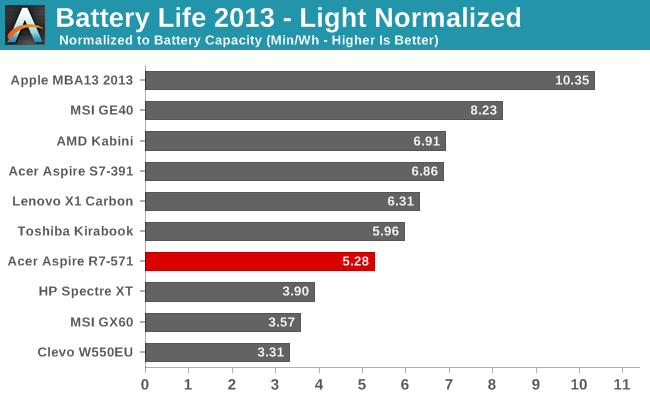
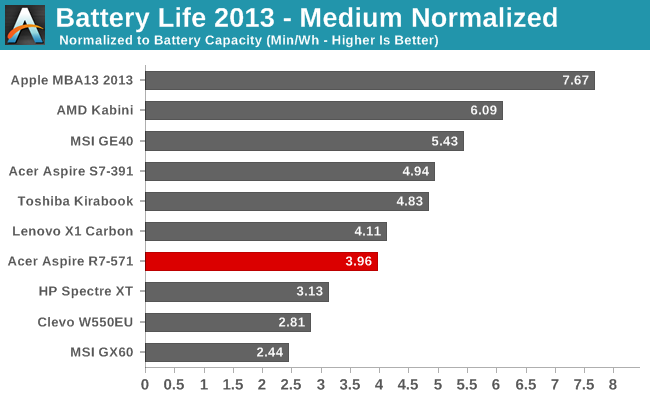
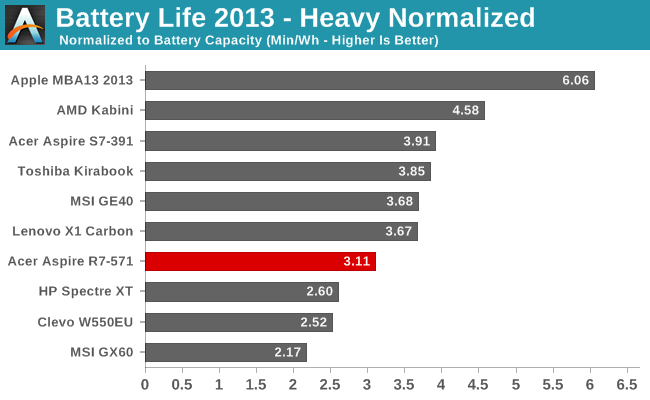
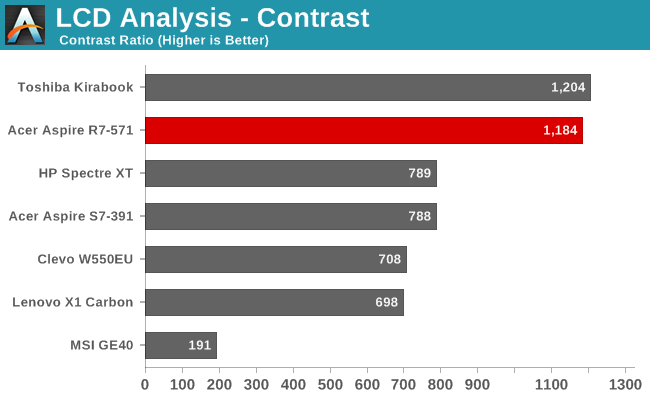

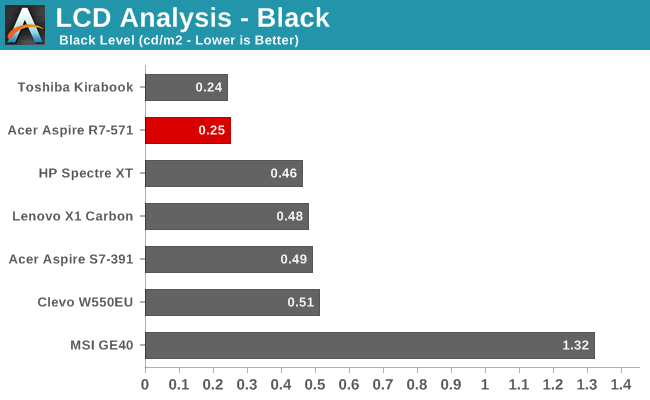
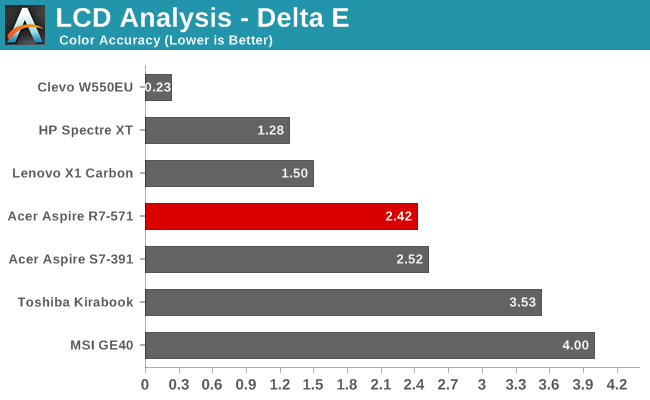
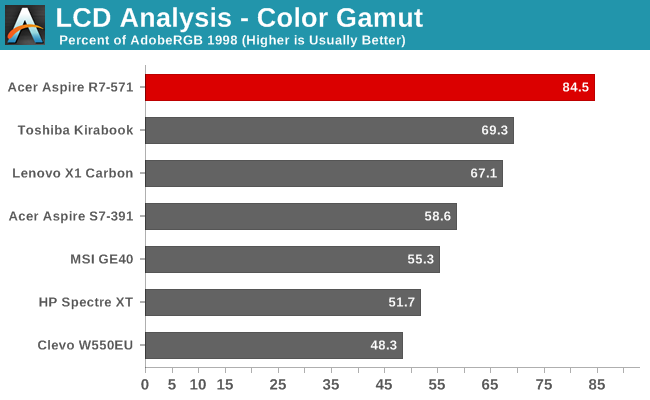
Whew! That’s a lot of benchmarks, and there are even more results in Mobile Bench – like if you really want to know how the R7 handles our gaming suite, for example, it’s there! If you don’t want to look but want a short summary, only one game gets above 10FPS at the Enthusiast settings, and just barely; with Mainstream most of the games fall in the 10-20FPS range, so basically unplayable. Even our Value gaming settings are mostly too much for the HD 4000, though most of the Windows 8 games in the Store are far less demanding and will run just fine – no surprise given most of those are targeting Windows RT, which means GPUs that are often less than half as fast as the HD 4000.
Elsewhere, CPU performance is about where you’d expect it: lower than Core i7 ULV/ULT, and similar to other Core i5 ULV parts. The hybrid storage solution means that PCMark7 doesn’t score quite as well as pure SSDs, but it’s still a huge step up from what you’d get from a pure HDD setup (e.g. GX60). Since I just mentioned the GX60, it’s also interesting to note that Core i5 ULV generally posts better CPU performance than AMD’s Richland APUs – though the second pass of x264 HD at least put AMD slightly ahead. GPU performance is nothing to write home about; it’s more than sufficient for running most Windows tasks, but anything graphically intensive is best off served by a dedicated GPU (or at the very least Intel’s Iris HD Graphics Iris Pro).
Battery life isn’t particularly stellar, but we’ve also seen worse – sometimes much worse. Realistically, four hours of light use is possible off a single charge, while heavier workloads will bring you closer to 2.5 hours. That puts the R7 slightly ahead of the Lenovo X1 Carbon in most tests, but only thanks to its higher battery capacity. In terms of normalized battery life, the R7 places fourth from last of the tested notebooks, and given that Clevo typically doesn’t optimized very well for power use and the MSI GX60 is classified as a gaming notebook, only the win over the HP Spectre XT TouchSmart is really worth mentioning. When we start to look at Haswell-based notebooks, even though Ivy Bridge was pretty good it looks pretty poor in light of what’s now available. Apple’s MacBook Air 13 runs at different OS, but the MSI GE40 has a quad-core Haswell CPU and a slightly larger battery, with about 50% more battery life than the Acer R7.
Wrapping up the benchmarks, as I mentioned before, the one standout item in the R7 is the display. Contrast is excellent, and color quality is at least decent – the 85% color gamut is actually a bit overblown, however, as some of the colors are actually outside of the Adobe RGB 1998 color space while others fall far short (green in particular is lacking). Still, the great viewing angles offered by AHVA combined with good overall performance definitely deserve commendation.










113 Comments
View All Comments
themossie - Thursday, August 15, 2013 - link
I sit 3-4 feet from my monitor depending (it's on an arm) - 27" 16:9 is quite wide, and not all that long ago a 27" monitor was unheard of for consumers :-)Can you show me some popular examples of this 'type search right -> glance left design' ? You
may be right, but can't think of any programs I use that do this other than CTRL+F in web browsers.
All programs I use:
1. "annoying popup in middle of screen for search" (sigh)
2. search bar along top/bottom
I strongly prefer glancing up or down (like reading a page of text) to left/right (switching between two pages of a book?) - maybe that's just me.
rainking430 - Thursday, August 15, 2013 - link
I upgraded from 7 to 8.0 on a non-touchscreen 27" monitor myself and hadn't been bothered as much about that difference. That said, have you used the 8.1 Preview? All search results show up in the search bar now.themossie - Thursday, August 15, 2013 - link
Haven't seen this, just looked up some screenshots. Thanks for the information!I'm still on Windows 7, that observation was from running Windows 8 in a VM. Might fire up 8.1 for fun.
sheh - Thursday, August 15, 2013 - link
I was checking at Panelook. Can't say how accurate they are, but they SEEM like they should be.If it is 6-bit and you can't see it, perhaps the DPI helps.
themossie - Thursday, August 15, 2013 - link
pg. 2: *lion's share of the duty. Late or spellcheck failure :-)"It’s the other three modes that are going to pull the ***lines share of the duty, so let’s look at each of those."
Thanks for the article!
JarredWalton - Thursday, August 15, 2013 - link
Actually, it was Dragon Naturally Speaking. I picked that back up and have used it for some of the dictation in some of my recent articles. Funny that they missed that one.damianrobertjones - Thursday, August 15, 2013 - link
"Also, grabbing smaller elements like scrollbars for the edge of a window to resize can be difficult with a touchscreen – there’s just not enough precision to pull it off properly." - Increase the DPI. Personally I don't see an issue."this design revolution comes up a bit short – much like Windows 8 itself." - Please, just stop already, it's obvious that you, personally, do not like Windows 8.
"Obviously, this is just one man's opinion on the subject, but if you scour the web you'll find many others with a similar take on Windows 8" - But as you suggested there's a whole load of people that DO like Windows 8.
Certain sections of this article really do need to be changed as it's painfully obvious what the agenda is. If a reviewer doesn't like Windows 8 then just give the device to someone else to review.
rainking430 - Thursday, August 15, 2013 - link
Agreed. This is labeled a review, not an opinion article. It's a shame really, because I've enjoyed Jarred's reviews up till now and thought he was doing a decent job. Hadn't noticed such extreme bashing before.JarredWalton - Thursday, August 15, 2013 - link
All reviews are opinions, and when a laptop/device is very clearly designed around the idea of Windows 8, that's going to be a major part of the review. Increasing DPI doesn't address the Excel issue. Without going into a menu, make a cell bigger, using just a touchscreen. To do this, you have to adjust the column width or row height, but while you can double-tap to get the autosize option, you cannot actually press and drag to create a custom size. Period.The response is of course the Steve Jobs line: "You're doing it wrong! It's not what I do, so why would anyone else want to do that?"
Anyway, I wasn't aware that we had any sacred cows in the computing industry. I'll make a note of the fact that any time I have an opinion that may ruffle some feathers, I should turn over a review to someone that doesn't have an opinion on the matter. Is that really what people need?
I'm trying to bring up some hard questions, and other than a lot of "you're totally wrong", "you should just stop", and "you just need to give it a try without bias", no one is actually giving any real solution to the problem. The problem is that I and a lot of others don't like the Windows 8 Start Screen or Metro apps, specifically on a desktop or full laptop. What is the end game here, and how does it play out?
I didn't love Vista at first blush, but I didn't find it horrible (other than driver support for some devices). Win7 was basically thumbs up from the start, and the same goes for Windows XP, 98, and even 95. (I left out WinME on purpose.) Windows 8 on the other hand is Windows 7 in so many ways, but then with the whole new world of Metro overlayed in ways that often frustrate. Get rid of Metro and it's fine, except when Metro tries to rise from the dead (like creating a new user account).
I'm not a huge Apple fan, having never really enjoyed using OS X much, but I'll go on record and say that it may be years or even "never" before Apple tries to integrate touchscreens and iOS apps into OSX. Microsoft did something Apple has so far been unwilling to do (trying to combine two disparate OSes and apps into one unified whole). Until we get screens that don't smudge or scratch, and applications for everything (not just consumption) that are designed to work well with touchscreen input, I at least am not clamoring for touchscreens.
ddriver - Thursday, August 15, 2013 - link
2 different 3D mark tests but not a single actual game? Does 3d mark synthetic performance tests favor intel's IGPs?